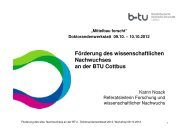Multilevel Graph Clustering with Density-Based Quality Measures
Multilevel Graph Clustering with Density-Based Quality Measures
Multilevel Graph Clustering with Density-Based Quality Measures
Create successful ePaper yourself
Turn your PDF publications into a flip-book with our unique Google optimized e-Paper software.
3.4 Cluster Refinementleave the local optimum, for example sequences of quality decreasing moves orcrossing different locally optimal clusterings.basin problem Many low-quality local optima in a bigger valley <strong>with</strong> better optimabeing far away. In order to reach them several local optima of low-qualityhave to be passed. This is also known as funnels in the context of simulatedannealing and similar methods.plateau problem The search space has nearly the same quality everywhere exceptfor some very local peaks. Thus there is no local information about the rightdirection of search and most heuristics would be as good as random search.Monte-Carlo methods or a mathematical derivation of search directions mighthelp here.ridge problem The direction of motion in the search space is different to the true directionof quality improvements. This might happen for example <strong>with</strong> heuristicselection criteria as a trade off to computational efforts. Also heuristicsfor leaving local optima can exhibit this property. This may be detected bychecking <strong>with</strong> other selection criteria.multi-level reduction problem The global optimal clustering of the original graphis most likely not a local optimum in coarsened graphs because it is not representablewhen vertices of different clusters are merged together. Inverselya global optimum of a coarse graph not necessarily leads to the real globaloptimum of the original graph after projection and refinement. Improvementsmight be possible by considering multiple candidate clusterings or applyingseveral multi-level passes <strong>with</strong> different coarsening hierarchies.This leads to apparently conflicting objectives. As there is no reason to acceptobviously improvable clusterings it is necessary to fully exploit local optima <strong>with</strong>outstopping half way. On the other hand exploring a wider range of local optima requiresto leave local optima and even avoid already explored optima. Therefore thefirst important step towards reliable refinement algorithms is the design of greedyrefinement and search algorithms. Later search and greedy refinement may be combinedto effectively explore a wide search space <strong>with</strong>out missing local optima.The next section explores the design space of refinement methods based on localoperations like moving single vertices. After classifying concrete algorithms the secondsection discusses the implemented greedy algorithms. The third section presentsthe adaption of the well-known Kernighan-Lin refinement to modularity clustering.3.4.1 Design Space of Local Refinement AlgorithmsThis section explores components of simple refinement strategies <strong>with</strong> just two basicoperations: moving a single vertex to another cluster, and moving a vertex intoa new cluster. The analysis is based on often used implementations like greedyrefinement [44], Kernighan-Lin refinement [45, 24, 58], simulated annealing [39, 38,68] and Extremal Optimization [23, 11, 10] while looking for common componentsand differences.43






